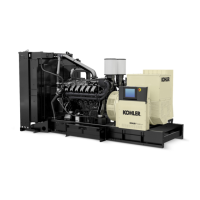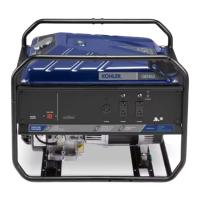TP-7070 7/18 89Section 3 Scheduled Maintenance
Sampling Method
1. Read and follow the safety precautions in
Sections 3.1 and 3.8.1.
2. Place a basin under the drain point.
3. Turn the cap on the expansion tank to the first notch
to release the pressure, then remove it completely.
4. Open the drain point.
5. Allow about one liter (1 qt.) of liquid to flow out
before collecting the sample
6. Collect about 1 liter (1 qt.) of liquid.
7. Close the bottle by tightly screwing the cap and
check the information on the label.
8. Close the drain point.
9. To p up the engine coolant if necessary.
10. Put the expansion tank cap in place and close.
3.8.8 Radiator Maint enance
Use the following list for radiator maintenance:
D Periodically check for leakage from the core or tank
connections.
D Inspect the liquid level at regular intervals using the
top tank sight glass.
D Test antifreeze before cold weather periods.
D If the unit is on stand-by for long periods of time,
check the interior of the top tank through the fill neck
for signs of scale or rust every one to three months. If
necessary, the radiator should b e cleaned, flushed,
and treated.
D Dirt and debris can be removed from the core face
with compressed air, steam, or water, if required. If
water is used, slowly increase the pressure and stand
at least 0.9 m (3 feet) away from the core. Keep the
water stream parallel with the fins in order to avoid
damaging them.
Note: Ensure that fins and tubes are not damaged from
rough brushing or excessive jet pressure of the
steam, air, or water.
D Clean fan blades once per year. Use a stiff brush or an
air nozzle for loose d irt and a nonflammable solvent
with brush for solid deposits. Care must be taken not
to damage the fan blades as a resulting
out-of--balance condition might cause vibration and
damage to fan bearings or motor bearings.
